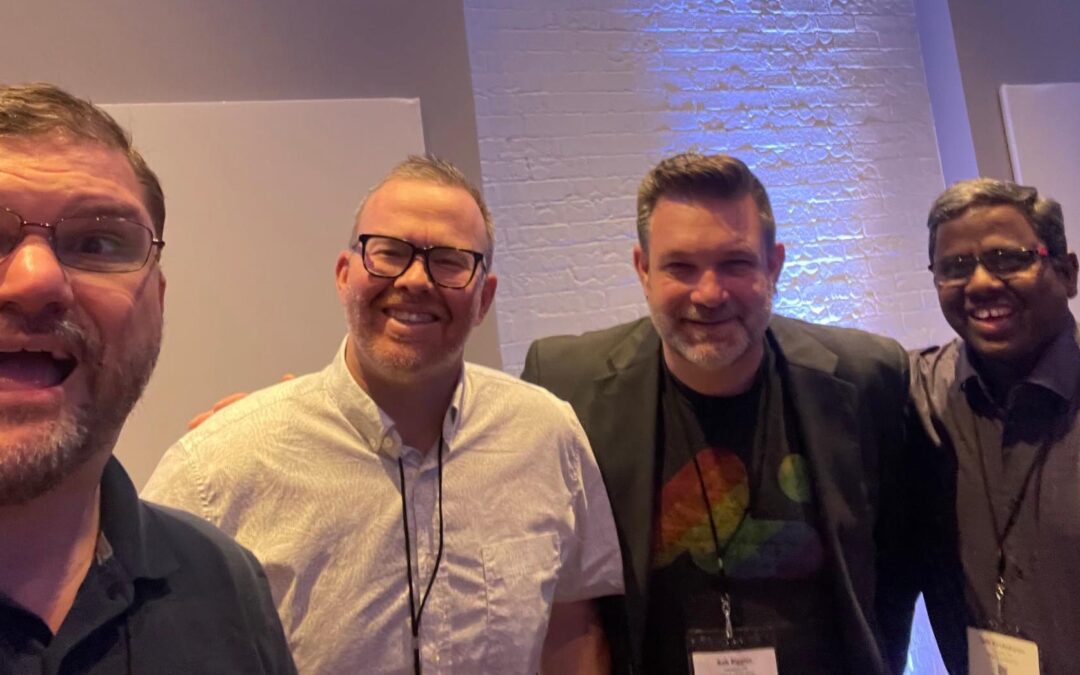Pictured left to right are Dwayne Stinson (VA Conference Associate Director of Influencing Ministries), Jake McGlothin (Restoration), Bob Riggles (Sydenstricker), and Sam Kirubakaran (Indian Church RVA).
By Dwayne Stinson
Church planters and ministry innovators gathered in Dallas at the 2022 Planters’ Gathering, April 26-27, 2022, to hear from seasoned leaders in church planting ministries and experienced practitioners.
Takeaway 1: Church planting faces shifts from pandemic, priorities of younger generations
The Rev. Rachel Gilmore, a VAUMC elder and planter, and Tyler Sit, both leaders in Intersect Co-Planting Network, presented on five major shifts in church planting that are responses to cultural shifts. These shifts are the result of and a response to the post-pandemic realities churches are facing; yet they also reflect the shift in priorities of younger generations whose giving patterns and social concerns distinguish them from traditional church-goers. For the church to continue to share the gospel, we too must rethink how we reach those outside the walls.
These shifts include:
- A shift from “Sunday-centric” to “Gathering-centric” experiences. Experimentation and Fresh Expressions will be the norm.
- A shift in leadership from ordained elders to lay planters. The ordination process is not replacing retiring clergy, and a shift in thinking towards the empowerment of the laity in their ministry means the role of elder will shift. Elders’ ministry will be focused on empowering and equipping laity to do ministry.
- A shift from building-centric to belief-centric ministry, as Generation Alpha (those born 2010 or after) and Millennials seek congregations that are active in the community. They are less concerned about a building than they are about the impact the church is making.
- A shift from in-person experiences to hybrid, as online community becomes more of a norm. 41% of Gen Z and 42% of millennials state that they are interested in returning to in-person worship, which means the majority are looking for virtual options.
- A shift to co-vocational churches, as churches and pastors build streams of income, including for-profit ventures, that connect with the mission and vision of the church but that provide additional income for the ministry. Imagine a church with a drive-through window and a coffee shop that serves the public as a business, not a ministry. Income from the coffee shop then provides resources for the missional work of the congregation. The shop itself is not a ministry, simply a space for the community to gather and get good coffee.
Takeaway 2: God is calling us to inclusiveness
Mark DeYmaz presented a workshop on the Multi-Ethnic Church, sharing the work of his three books (Building a Healthy Multi-Ethnic Church, Multiethnic Conversations, and Leading a Healthy Multi-Ethnic Church. He shared the “three pillars” of the multiethnic church, which provide the theological foundation for multiethnic church ministry:
- Envisioned by Christ (John 17)
- Described by “Luke” (Acts 11/13)
- Practiced by Paul (Ephesians)
He also shared seven “Core Commitments” required to build a healthy multi-ethnic church:
- Embrace dependence on God/the Holy Spirit.
- Take intentional steps, rejecting the principle (the “homogeneous unit principle”) which says church plants have to be completely homogeneous to be successful. Ministries may have a linguistic or cultural focus to help people overcome those barriers, but the church itself should never be homogeneous.
- Empower diverse leaders.
- Develop cross-Cultural relationships.
- Pursue cross-Cultural competence (CQ)
- Promote a spirit of inclusion (“Accommodation, not Assimilation”).
- Mobilize for impact.
Takeaway 3: Disrupt your church’s approach to ministry funding
DeYmaz also presented a keynote address on the future of church finances. He suggests that we should think of church leadership as a “team of teams”:
- A Spiritual Team, which does what churches do (worship, discipleship, etc), led by a visionary leader, typically the lead/senior pastor.
- A Financial Team, responsible for financial entrepreneurship and led by a “CEO type” with a business background
- A Social team, focused on the holistic needs of the church’s specific community, led by an Executive Director, an “MSW type” (Master of Social Work), who also works on securing grants and donations.
DeYmaz talked about disruptions necessary for the church of the future, including disruptive witness and disruptive economics.
He acknowledged that giving patterns among Gen X and Millennials have shifted from those 65+, and that “people in the pews” cannot financially sustain a ministry. In one congregation DeYmaz studied, for every giver over 65 the church lost, it took 7 younger and more diverse givers simply to make up for that giving. However, because of the increased numbers, the church budget increases as the church adds more staff and programming to serve the larger numbers, so it is an endless chase with no chance of reaching a break-even. A disruptive shift in the church’s approach to funding ministry is necessary to address the generational shifts the church faces. Books from DeYmaz on the subject include: The Coming Revolution in Church Economics: Why Tithes and Offerings are No Longer Enough and What You Can Do About It and Disruption: Repurposing the Church to Redeem the Community.

